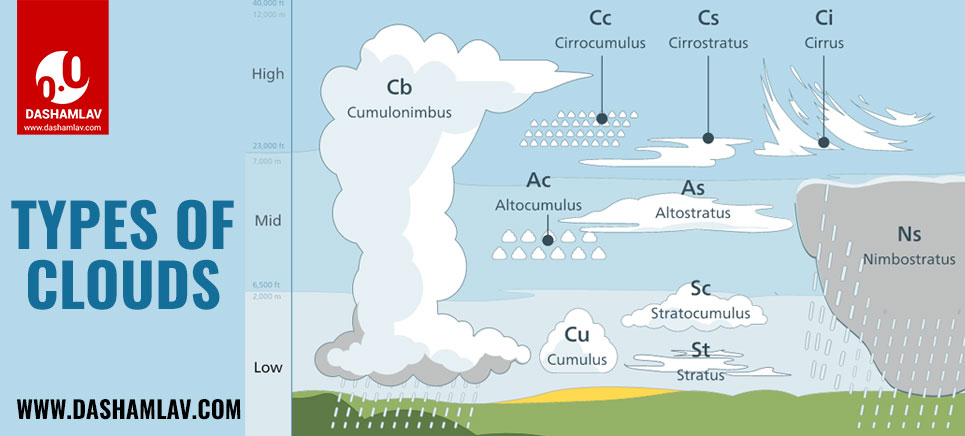Clouds are the visible mass or accumulation of tiny water droplets and ice crystals floating in the Earth’s atmosphere. They are an important part of the earth’s weather and climate. Clouds are important for any form of precipitation. They also help in balancing the earth’s temperature by reflecting heat to the earth during the night and shielding the earth from excessive sunlight during the daytime.
How do clouds form?
Water on earth transforms into water vapor through processes like evaporation and transpiration. These water vapors from the earth rise up in the atmosphere and condense around tiny particles, like dust, floating in the atmosphere. The mass of water droplets thus formed are termed as clouds.
Although all clouds are formed in the same manner, there are a variety of clouds that we can see in the sky. Temperature and wind are the two most important factors that determine the form of a cloud.
Classification of Clouds
Clouds are classified mainly based on two factors – their physical form or shape and the altitude of their formation.
Classification of Clouds based on their shape
1. Cirrus Clouds
These are short, detached and feathery clouds found at high altitudes. These delicate clouds have a silky sheen. They are whiter than any other cloud during the daytime while they may take the color of sunrise and sunset during dawn and dusk respectively.
2. Cumulus Clouds
These are the clouds with a flat base and a fluffy cotton-like appearance. They exist in patches and may be seen dispersed here and there.
(Fun Fact: This is the cloud we all drew as kids 😉 )
3. Stratus Clouds
These are the low lying clouds with fairly uniform grey or white in color. These are the lowest-lying clouds that sometimes appear at the surface of the earth in the form of fog or mist.
4. Nimbus Clouds
Nimbus clouds are the precipitation bringing clouds. They are usually dark grey or black as they hold bigger droplets of water that blocks the sunlight. These clouds are normally formed at a lower altitude.

Classification of Clouds based on the Altitude of Their Formation
1. High Clouds
The clouds formed at relatively higher altitudes as compared to other clouds are classified as high clouds. These can reach above 20,000 feet. These clouds are usually thin and made up of ice. The presence of these clouds indicates clear weather and do not cause rain. Cirrus Clouds are an example of high clouds.
2. Middle Clouds
These are the clouds that are formed above 6,500 feet up to the level of High Clouds. The presence of middle clouds indicates an approaching storm. They may sometimes produce Virga i.e. precipitation that does not reach the ground. The precipitation from these clouds evaporates or sublimates before reaching the ground.
3. Low Clouds
The clouds lying below 6,500 feet are termed as low clouds. They are also called stratus clouds. These clouds may appear dense, dark and rainy or may also be cottony white clusters interspersed with blue sky.
Clouds with extensive vertical development or Great Vertical Extent Clouds
These are the special kinds of clouds that do not fit exactly in any of the above classifications. These are the most dramatic clouds which are also known as storm clouds. They rise dramatically to a great height which can sometimes be well above the transcontinental jetliner flights.
| Classification of Clouds | Types of Clouds |
|---|---|
| Low Clouds | 1. Stratocumulus Clouds 2. Nimbostratus Clouds |
| Middle Clouds | 1. Altostratus Clouds 2. Altocumulus Clouds |
| High Clouds | 1. Cirrus Clouds 2. Cirrostratus Clouds 3. Cirrocumulus Clouds |
| Great Vertical Extent Clouds | 1. Cumulus Clouds 2. Cumulonimbus Clouds |
Frequently Asked Questions
Q. What is the study of clouds known as?
A. Nephology. The branch of meteorology concerned with the cloud types, formation, development and dissipation is called Nephology.
Q. Which cloud is the highest?
A. Noctilucent or the night shining cloud is the highest of all clouds. However, it is not related to weather as the other clouds discussed above.
Q. Is fog a cloud?
A. Yes, fog is a type of cloud that touches the ground.
Q. Why are clouds white?
A. The tiny droplets of water and ice contained in clouds are just the right size to scatter all the colors of visible light. When light contains all seven colors, our eyes perceive it as white. So, clouds appear white to our eyes.
Q. Why are some clouds grey or dark?
A. The bigger water droplets in the heavier clouds block sunlight and hence they appear dark to us.
Q. Which type of clouds brings snowfall and rainfall?
A. The clouds with the prefix ‘nimbo’ and suffix ‘nimbus’ bring precipitation (i.e. rain and snow).
Q. How does cloud float?
A. Warm air from earth constantly rises up. This warm air from the earth pushes up the clouds and keeps them afloat.
Q. What is the International Cloud Atlas?
A. The International Cloud Atlas describes the classification system for clouds and meteorological phenomena used by all World Meteorological Organization members.
Use the citation below to add this article to your bibliography
"How do Clouds Form? Types & Classification of Clouds." Dashamlav.com. Web. 13 June 2025. <https://dashamlav.com/cloud-types-classification-rain-snow/>
Dashamlav.com, "How do Clouds Form? Types & Classification of Clouds." Accessed 13 June 2025. https://dashamlav.com/cloud-types-classification-rain-snow/
"How do Clouds Form? Types & Classification of Clouds." (n.d.). Dashamlav.com. Retrieved 13 June 2025 from https://dashamlav.com/cloud-types-classification-rain-snow/
